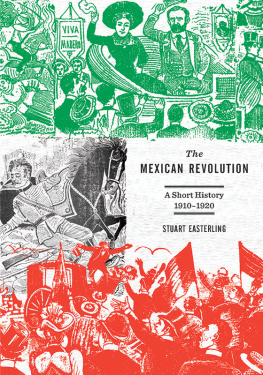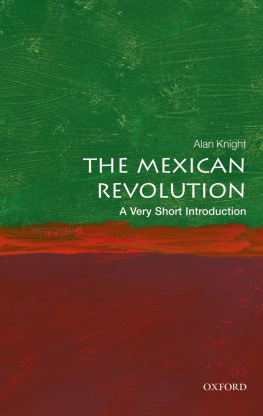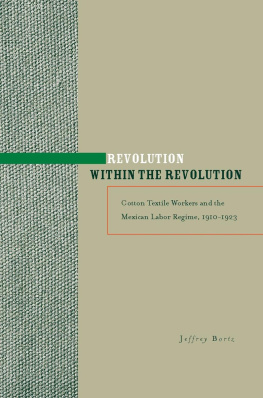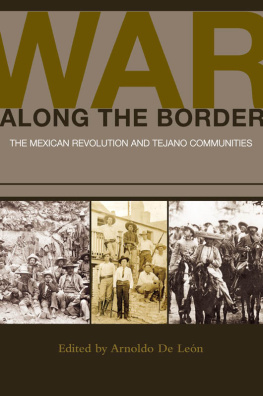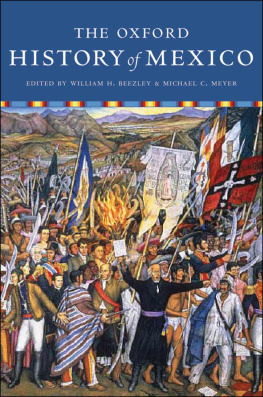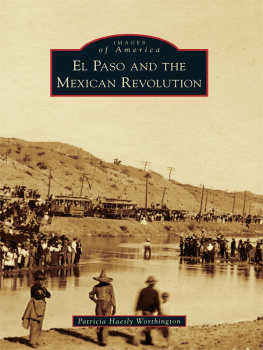This eBook is licensed to Will Yang, williamyang1997@hotmail.com on 09/21/2019
Contents
This eBook is licensed to Will Yang, williamyang1997@hotmail.com on 09/21/2019
Timeline of Major Events
February 1908: Aging dictator Porfirio Daz gives the widely discussed Creelman interview, where he speaks of his openness to an opposition presidential candidate in Mexico.
September 1909: Emiliano Zapata is elected village president of Anenecuilco, Morelos. Campesinos led by Zapata begin repossessing land from the local sugar haciendas.
April 1910: Francisco Madero officially launches an opposition presidential campaign, gaining widespread support.
June 1910: Madero is jailed by the Daz regime, for attempts at rebellion and insults to the authorities.
July 1910: Daz is dubiously elected president for the eighth time.
October 1910: Madero escapes from jail and issues his call to revolt, the Plan de San Luis Potos. The Plan calls for political democracy in Mexico, and vaguely states that agrarian questions would be subject to review in a post-Daz government.
November 1910May 1911: Maderos revolt begins slowly and then gathers steam, especially in the Mexican north. Pancho Villa, a former bandit, joins the rebellion against Daz in Chihuahua. In Morelos, Zapatas forces do battle with Dazs Federal Army.
May 1911: Following numerous defeats at the hands of the rebels, Daz resigns the presidency and leaves for exile in Europe.
October 1911: Madero is elected president of Mexico.
November 1911: Zapata and his followers break publicly with Madero, and accuse him of betraying the agrarian cause. They issue the Plan de Ayala, calling for radical agrarian reform in Mexico. Madero orders the Federal Army to put down the Zapatista rebellion.
May 1912: General Victoriano Huerta, a conservative Porfirian-era general, has Pancho Villa arrested on charges of stealing a horse. Villa has remained a loyal supporter of Madero and is already a popular militia leader in Chihuahua. Villa barely avoids execution and is instead jailed in Mexico City.
December 1912: Villa escapes from prison in Mexico City and flees to Texas.
February 1913: General Huerta overthrows Madero during the Tragic Ten Days (Decena Trgica), with the backing of the US Embassy in Mexico. Soon after, Huerta has Madero and his vice president assassinated.
March 1913: The Constitutionalists are formed, under the leadership of Venustiano Carranza, a landlord and the governor of Coahuila. They issue the Plan de Guadalupe, which calls for Huertas ouster but, in line with Carranzas relative conservatism, makes no mention of agrarian or social reform. lvaro Obregn, a man with past experience as a pro-Madero militia leader, joins the Constitutionalists in Sonora and eventually becomes a general under Carranzas command.
March 1913: Villa returns to Mexico with a small band of fighters. A few months later he will command the Constitutionalists Northern Division, the most feared and powerful army in Mexico. Although nominally subordinate to Carranza, Villa chafes at Carranzas authority and disagrees with his conservative stance on agrarian and social questions.
May 1913: The Casa del Obrero Mundial, a new labor federation, calls the first major May Day demonstration in Mexican history.
191314: The Constitutionalist forcesespecially the Northern Divisionscore multiple victories against the Federal Army.
April 1914: The Woodrow Wilson administration, in an effort to influence events in Mexico, orders US naval forces to attack and occupy the Gulf Coast city of Veracruz.
July 1914: Huerta resigns the presidency and flees Mexico. Carranza and his Constitutionalist forces take Mexico City. The old Federal Army is abolished.
JulyOctober 1914: The tensions between Villa and Carranza come to the surface. Zapata continues to disavow Carranzas authority, due to Carranzas opposition to land reform. Villa eventually declares himself and the Northern Division to be independent of Carranzas command.
OctoberNovember 1914: The revolutionary military officers gather at the Aguascalientes Convention to settle their differences and decide the future of Mexico. Carranza holds firmly to the position that he should be president of Mexico. Yet the Convention swings to Villa and Zapatas side and declares its support for agrarian and social reform. Carranza is eventually declared to be in rebellion against the Convention.
November 1914: Carranza and his followers, including Obregn, leave Mexico City and retreat to Veracruz. US troops end their occupation.
December 1914: Villa and Zapata meet for the first time, and their forces enter Mexico City. The Convention establishes a government in the capital. Villa and Zapata soon return to their home bases in Chihuahua and Morelos.
January 1915: Under pressure from Obregn, Carranza issues his own agrarian and social reform program.
February 1915: Obregn retakes Mexico City, following Villa and Zapatas departure from the capital. Obregn forms an alliance with the Casa del Obrero Mundial, recruiting thousands of urban workers into his army.
AprilJune 1915: Obregn faces Villa in several major battles in the center-north Bajo region. Villa and the Northern Division are decisively defeated. Villa returns to the terrain of guerrilla warfare.
July 1915: Carranza returns to Mexico City and assumes the presidency of Mexico.
191519: Carranzas forces do battle with Zapatas increasingly isolated forces in Morelos but are unable to fully suppress the Zapatistas.
March 1916: Following numerous guerrilla raids in Chihuahua, Villa crosses the US-Mexico border and attacks Columbus, New Mexico, provoking an armed expedition by US troops in pursuit of him.
July 1916: The Casa del Obrero Mundial calls a general strike in Mexico City, demanding that workers be paid in gold rather than paper currency. Carranzas government puts down the strike by force.
December 1916February 1917: Delegates in Quertaro draft Mexicos 1917 Constitution. Radicals in the Constitutionalist camp enshrine numerous social reforms in the final version, against Carranzas wishes.
April 1919: Zapata is killed by treachery, when meeting a Constitutionalist officer who claimed he wished to join forces with him.
June 1919: A disgruntled Obregn announces his presidential candidacy, against Carranzas wishes. Obregn receives the backing of Zapatas followers and the trade unions. Carranza instead declares his support for one of his own close loyalists.
April 1920: Facing charges of treason brought by Carranzas government, Obregn rebels and receives widespread backing from the Constitutionalist army.
May 1920: Carranza flees to Veracruz but is killed en route.
June 1920: A caretaker president reaches a peace agreement with Villa.
December 1920: Obregn assumes the presidency of Mexico.
This eBook is licensed to Will Yang, williamyang1997@hotmail.com on 09/21/2019
List of Illustrations
This eBook is licensed to Will Yang, williamyang1997@hotmail.com on 09/21/2019
Setting the Stage
It is rare for a hundred-year-old revolution to remain a matter of debate and public controversy. Such is the case with Mexicos revolution of 191020, still the most significant event in the nations modern history.
The anniversary of the Revolutions outbreak, not surprisingly, is widely celebrated each year in Mexico. The official ceremonies pay tribute to its principal leaders: men like Francisco Madero, the idealistic scion of a landowning family, whose call for democracy in Mexico sparked a wider revolt; Emiliano Zapata, the radical agrarian leader who mobilized villagers in the southern state of Morelos and beyond; Pancho Villa, the audacious ex-bandit and popular chieftain from Chihuahua; Venustiano Carranza, the aristocratic state governor turned rebel; and lvaro Obregn, the brilliant military and political strategist, who in 1920 assumed the presidency after ten years of conflict and popular upheaval.
Next page
